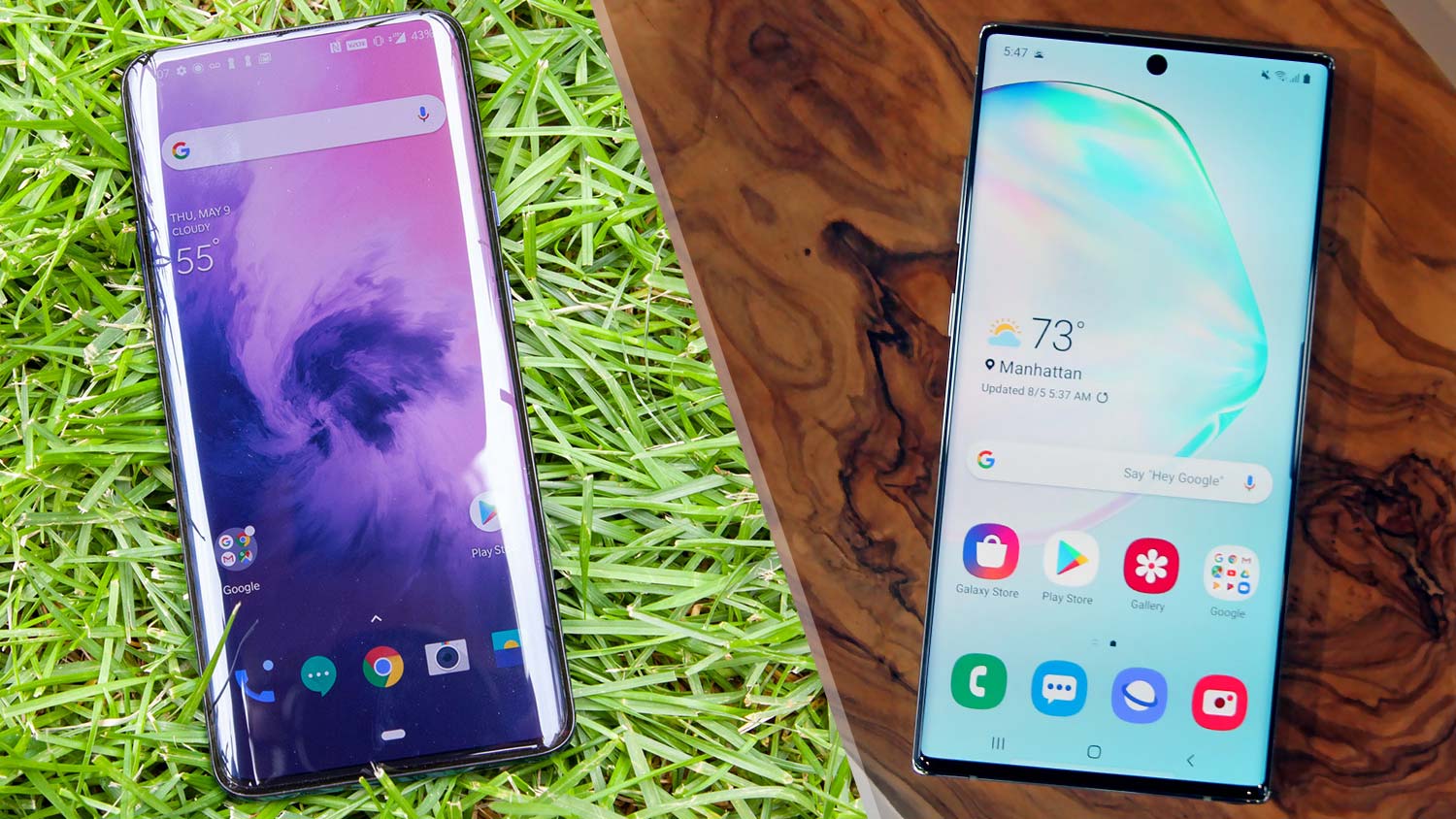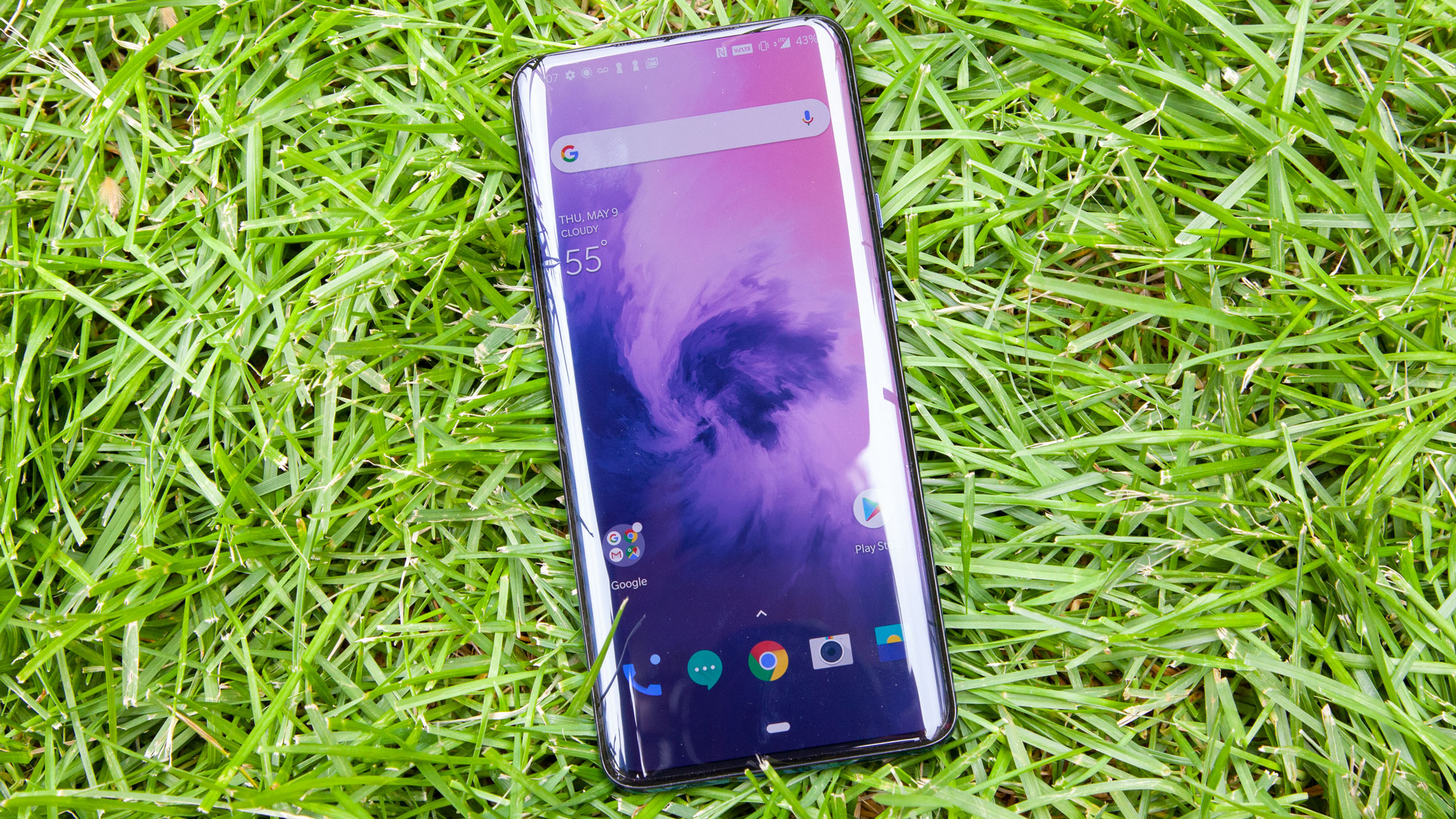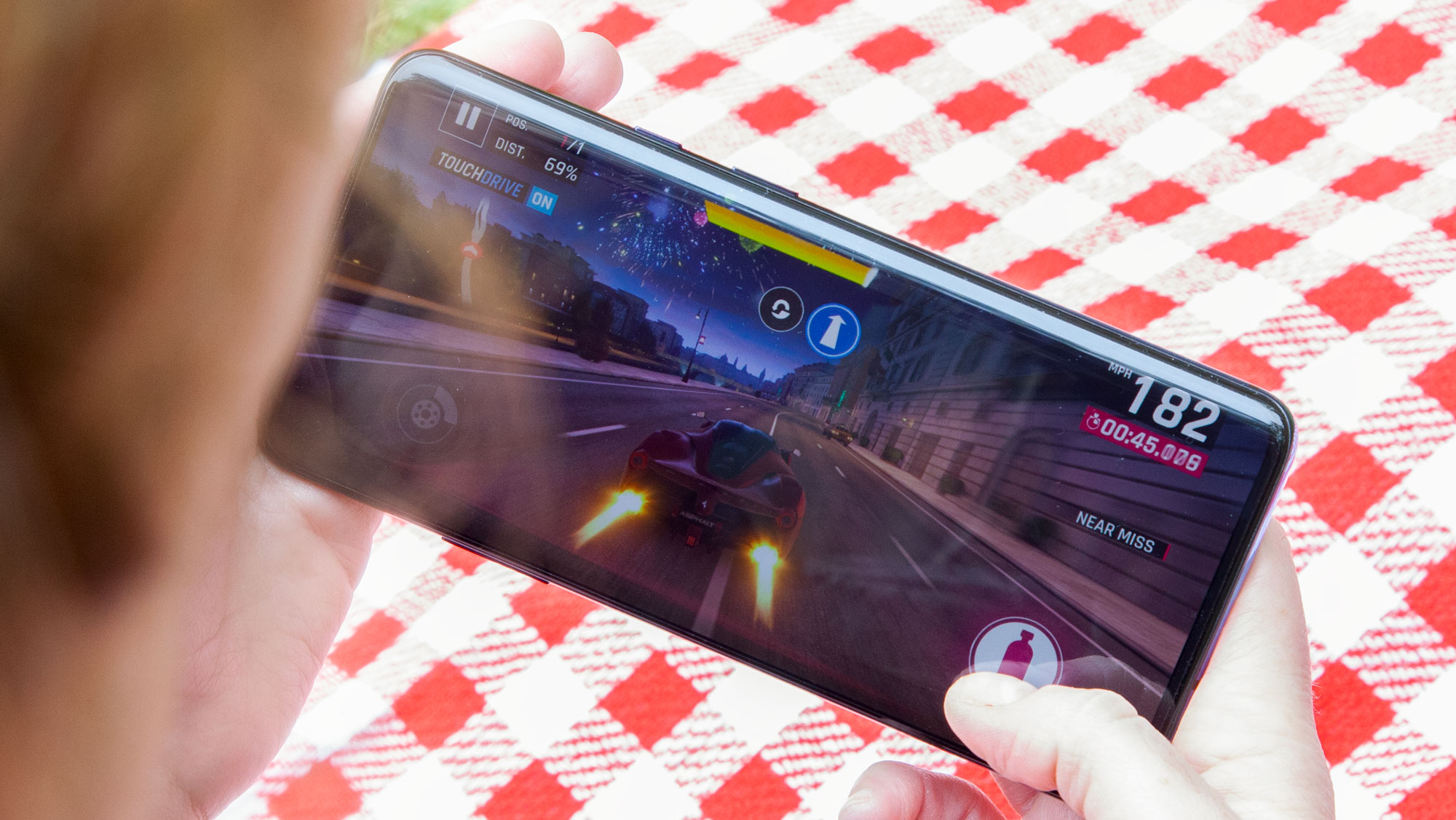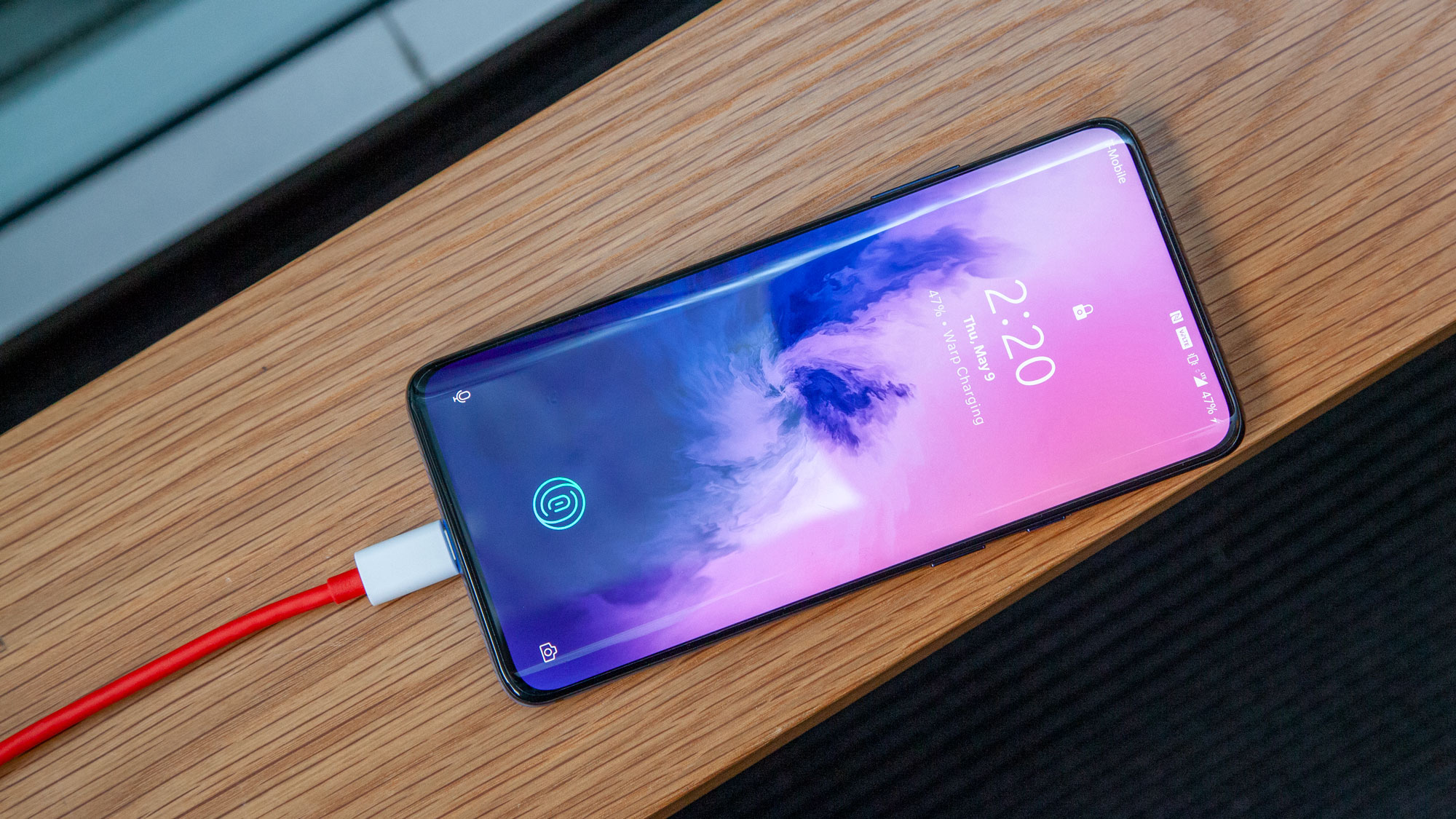Galaxy Note 10 vs. OnePlus 7 Pro: Specs Compared
Samsung's phablet takes on OnePlus' bargain

Samsung is charting an unusual path for its phablets with the Galaxy Note 10 and Note 10 Plus. Gone are the days when the Note series meant a massive display you'd need a stylus to navigate. The 6.3-inch, $949 Note 10, with its impossibly slim bezels and Infinity-O camera cutout, is surprisingly pocketable.
In fact, the Galaxy Note 10 is even easier to operate with one hand than the 6.67-inch OnePlus 7 Pro. But even with that size difference, you'll actually find a wealth of similarities between the two devices. Both have top-of-the-line Snapdragon 855 processors; both feature triple-lens cameras on the back; and neither has a headphone jack, nor a microSD slot for expandable memory. (OK, so two out of three ain't bad.)
One thing the two handsets don't have in common is their price tags. The OnePlus 7 Pro begins at $669, while the Note 10 costs $949. Is the Note 10 really worth $180 more? We'll have a definitive answer once we spend more time with the Note 10, but for now, here's how the two phones compare.
Design

Regarding proportions and aesthetics, Samsung and OnePlus' latest flagships are polar opposites of one another. Whereas the OnePlus 7 Pro is a hulking beast of a handset, with a thick profile and a steeply curved back, the Note 10 is more of a classic slab, mostly flat across both sides.

In fact, the Note 10 is so much more efficient from a packaging standpoint that you almost forget you're holding it. At 5.9 ounces, the Note 10 is about 1.4 ounces lighter than the OnePlus 7 Pro. And while both phones are made chiefly of Gorilla Glass, Samsung and OnePlus have used different techniques for treating those materials. Most OnePlus 7 Pro colorways employ an etching process that gives its glass a matte feel, while the Note 10 is a glossy, unapologetic fingerprint magnet — especially in its Aura Glow guise.
It's a good thing, then, that you won't be searching around for a fingerprint sensor on the back of the Note 10. Samsung's device features an ultrasonic scanner baked right into the screen, just like the one inside its Galaxy S10. The OnePlus 7 Pro also has an in-screen sensor, though it's an optical one. As a result, it's not only a bit easier to spoof but harder to use in unfavorable conditions, like when the phone is wet.
That's not to say the OnePlus 7 Pro doesn't have futuristic tricks of its own. While Samsung opted for a hole-punch-style selfie camera for the Note 10, OnePlus' handset has a motorized, pop-up front-facing lens to eliminate as much of the phone's top bezel as possible. The camera is pretty snappy — fast enough to be used for Face Unlock — though it does make the OnePlus 7 Pro quite a bit thicker. Furthermore, although OnePlus is confident in the strength of the mechanism, we remain a bit skeptical. Adding moving parts where there typically are none just presents more opportunities for something to break.
The Note 10 has other design advantages over the OnePlus 7 Pro. Samsung's phablet is rated IP68 water resistant, whereas OnePlus says its handset can stand up to liquids while refusing to certify that claim. The Note 10 has the advantage of the S Pen for productivity-minded users, and can even recharge other devices wirelessly using Samsung's Wireless PowerShare feature. As stated earlier, neither device features a headphone jack or microSD slot (the latter is exclusive to the $1,099 Note 10 Plus).
Display

It's an open secret in tech circles that Samsung supplies most phone makers with its own displays. It's for this reason that you usually see the company save its most stunning AMOLED panels for its own phones.
Strangely, OnePlus must have missed that memo. The 6.67-inch, 90Hz, Quad-HD+ AMOLED screen in the OnePlus 7 Pro is arguably the finest we've seen all year, because it combines a fast refresh rate with a high resolution, as well as the inky blacks and vivid hues that only OLED technology provides.

By every indication, the 6.3-inch panel in the Note 10 will be as good as any Samsung's put in its smartphones before. Yet it still only runs at the standard 60Hz, and features a Full-HD+ resolution. For more pixels, you'll have to spring for the 6.8-inch Note 10 Plus — but even then, you're still missing out on the buttery-smooth scrolling and general responsiveness 90Hz offers. As much as we never expected to say it, it seems like Samsung will need to step up its display game.
Cameras

With the Note 10, you're getting the very same triple-camera setup on the back that debuted in the Galaxy S10. That's two 12-megapixel wide-angle and telephoto lenses, alongside a 16-MP ultrawide shooter. The main 12-MP lens can change aperture from ƒ/1.5 to ƒ/2.4, and the telephoto camera offers a 2x optical zoom.

While the OnePlus 7 Pro also packs three lenses in its rear camera stack, the setup is quite different on paper. The main lens here captures a whopping 48 megapixels, and uses pixel-binning to deliver optimized 12-MP shots with more detail than would ordinarily be captured at that resolution. The telephoto shooter maxes out at just 8 MP, but delivers 3x optical zoom. Meanwhile, the ultrawide lens is of the 16-MP variety, much like the Note 10's.
Both Samsung and OnePlus use an abundance of artificial intelligence to punch up images, with special modes for night photography as well as scene optimization when shooting specific objects and in particular conditions.
That said, not all camera software is equal — a fact we were reminded of when testing the OnePlus 7 Pro's camera against the Galaxy S10 Plus' earlier this year. The S10 Plus won that faceoff, and given that the Note 10 has the very same imaging hardware as Samsung's other flagship, we're inclined to believe Samsung will continue its advantage when we take both phones out for testing.
Specs
| Header Cell - Column 0 | OnePlus 7 Pro | Galaxy Note 10 | Galaxy Note 10 Plus |
|---|---|---|---|
| Price | $669, $699, $749 | $949 | $1,099 |
| Display | 6.67-inch 90Hz AMOLED (3120x1440) | 6.3-inch Dynamic AMOLED (2280x1080) | 6.8-inch Dynamic AMOLED (3040x1440) |
| CPU | Snapdragon 855 | Snapdragon 855 (US); Exynos 9825 (WW) | Snapdragon 855 (US); Exynos 9825 (WW) |
| RAM | 6GB, 8GB, 12GB | 8GB | 12GB |
| Storage | 128GB, 256GB | 256GB | 256GB, 512GB |
| microSD Slot? | No | No | Yes |
| Rear cameras | 48-MP (ƒ/1.6); 16-MP ultra-wide (ƒ/2.2); 8-MP telephoto (ƒ/2.4) | 12-MP (ƒ/1.5-ƒ/2.4); 16-MP ultra-wide (ƒ/2.2); 12-MP telephoto (ƒ/2.1) | 12-MP (ƒ/1.5-ƒ/2.4); 16-MP ultra-wide (ƒ/2.2); 12-MP telephoto (ƒ/2.1); time-of-flight VGA |
| Front cameras | 16-MP (ƒ/2.0) | 10-MP (ƒ/2.2) | 10-MP (ƒ/2.2) |
| Battery | 4,000 mAh | 3,500 mAh | 4,300 mAh |
| Charging | 30W | 25W; 45W optional | 25W; 45W optional |
| OS | Android 9 Pie with OxygenOS | Android 9 Pie with Samsung OneUI | Android 9 Pie with Samsung OneUI |
| Colors | Mirror Gray, Almond, Nebula Blue | Aura Glow, Aura White, Aura Black, Aura Red (non-US), Aura Pink (non-US) | Aura Glow, Aura White, Aura Black, Aura Blue |
| Size | 6.4 x 2.99 x 0.35 inches | 5.94 x 2.83 x 0.31 inches | 6.39 x 3.04 x 0.31 inches |
| Weight | 7.27 ounces | 5.93 ounces | 6.91 ounces |
Performance

Inside both phones beats Qualcomm's Snapdragon 855 system-on-chip — a processor that can be found in most Android flagships out this year.
Where the Note 10 and OnePlus 7 Pro differ mostly relates to RAM. The Note 10 exclusively comes with 8GB of memory and 256GB of storage, while the OnePlus 7 Pro ranges from 6GB of RAM and 128GB of storage at the low end (for $669) all the way up to 12GB/256GB for the priciest, $749 configuration.
The 12GB version of the OnePlus 7 Pro is among the fastest smartphones money can buy, at least regarding benchmarks. The phone's Geekbench 4 score of 11,227 was well within striking distance of the iPhone XS' 11,420 result. That's an impressive feat, considering the A12 Fusion processor inside Apple's handset has maintained a lead over Qualcomm's silicon throughout 2019.
The Note 10 likely won't top the OnePlus 7 Pro, given that it has 4GB less RAM. Rather, we're expecting the phablet to slot in nearer to the Galaxy S10's 10,732 score — so stay tuned.
Battery

On paper, you'd think the OnePlus 7 Pro has the Note 10 smoked here. OnePlus' flagship has a 4,000-mAh battery with the firm's 30W Warp Charge technology built in. Using the included charger, we were able to get the device back up to 60 percent capacity in just 30 minutes — and that's among the fastest charging speeds we've seen from any smartphone yet.

The Note 10 features a fast-charging battery of its own, though it's smaller, at 3,500 mAh, and tops up at a more pedestrian 25W using the packaged adapter. Eventually, Samsung says it'll release a 45W charger, which, given the Note 10 battery's trimmed-down capacity, should help it replenish even faster than the OnePlus 7 Pro can. But you'll have to pay extra for the charger — Samsung hasn't said how much the 45W kit will cost yet.
The Note 10 also notably features wireless charging, something the OnePlus 7 Pro lacks. Thanks to Wireless PowerShare, the Note 10 can also top up other devices, like Samsung's Galaxy Buds or Galaxy Watch, just by placing them on the back of the handset.
MORE: Best Phones of 2019
The OnePlus 7 Pro lasted 9 hours and 31 minutes in our battery test, which involves continuous web surfing over T-Mobile's LTE network. We're hoping the Note 10 can top that when we run the same test on Samsung's phablet.
Software and Special Features

Although the Note 10 and OnePlus 7 Pro each run Android 9 Pie, the user experience is markedly different across both devices.
Samsung's OneUI front end takes more than a few liberties with Google's operating system, shifting text and on-screen actions closer to the bottom of the display so they're easier to reach. In contrast, OnePlus' OxygenOS is laid out more similarly to stock Android but adds new functionality, like screen recording, Reading Mode and access to shortcuts straight from the fingerprint sensor.
The big difference between the two phones, of course, is Samsung's S Pen — the Bluetooth-connected stylus inside the Note 10. This year, the S Pen has been given motion sensors for air gestures, like swiping from side to side while holding the button to change camera modes. Additionally, the process for transcribing handwriting to text has been streamlined with the Note 10; it takes only a few taps to export handwritten notes to PDF or Microsoft Word in an editable text format.
Price and availability
The Note 10 begins shipping Aug. 23, and will cost $949 for its lone model offering 8GB of RAM and 256GB of storage. All four major carriers in the United States will sell the phone, which comes in a variety of colors, including black, white and the iridescent Aura Glow finish. If you want the larger, 6.8-inch Note 10 Plus, that will cost you at least $1,099 — more if you want a version of the phone that offers more storage or 5G connectivity.
MORE: Best Galaxy Note 10 Preorder Deals
The OnePlus 7 Pro starts at a much easier to swallow $669 for a Mirror Gray model with 6GB of RAM and 128GB of storage. Other colors, like Almond and Nebula Blue, cost at least $699 and feature at least 8GB of RAM. The range-topping 12GB/256GB model exclusively comes in Nebula Blue and costs $749.
OnePlus 7 Pro (Mirror Gray, 128GB): 6GB RAM, Dual Sim, 6.67 inch, 48MP Main Lens Triple Camera, GSM Unlocked International Model
At the moment, T-Mobile is the only major carrier that sells the OnePlus 7 Pro in store (though Sprint says it will sell a 5G OnePlus phone — most likely the OnePlus 7 Pro 5G). Otherwise, you can nab an unlocked model from OnePlus' website and bring it to AT&T, Verizon or a discount network of your choosing.
Outlook
If it's sheer performance you want, the OnePlus 7 Pro grants flagship-caliber speed for hundreds less than you'd pay for one of Samsung's priciest Galaxy S or Note devices.
However, if you overlook price, the Note 10 appears to be the better device all around. The design is more compact and versatile, thanks to the S Pen. The phablet is water resistant, can charge wirelessly and, from what we've observed in the past, should take better photos. The Note 10 will be easier to buy, with wider availability across more carriers.
The OnePlus 7 Pro offers advantages of its own, and anyone opting for it over the Note 10 shouldn't regret their decision — it's a wonderful phone. But if you are on the fence, you can check back for our full review on the new Note in the coming weeks.
Sign up to get the BEST of Tom's Guide direct to your inbox.
Get instant access to breaking news, the hottest reviews, great deals and helpful tips.
Adam Ismail is a staff writer at Jalopnik and previously worked on Tom's Guide covering smartphones, car tech and gaming. His love for all things mobile began with the original Motorola Droid; since then he’s owned a variety of Android and iOS-powered handsets, refusing to stay loyal to one platform. His work has also appeared on Digital Trends and GTPlanet. When he’s not fiddling with the latest devices, he’s at an indie pop show, recording a podcast or playing Sega Dreamcast.

